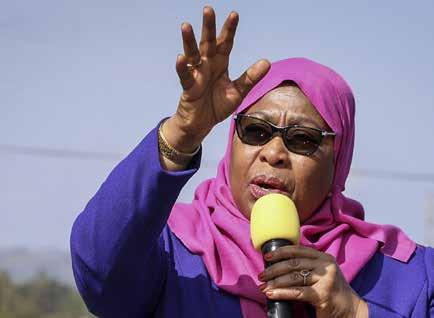
32 minute read
Tanzanian President lifts ban on media
President Suluhu Hassan
Many media outlets barred from operating in Tanzania mainly for criticizing former government Media houses in Tanzania that had been closed, banned or denied licenses to operate by the former government will now be allowed to reopen, the county’s president announced on Tuesday. In a move hailed as a positive future for press freedom in Tanzania, President Samia Suluhu ordered the Information Ministry to lift the ban on media outlets mainly for criticizing the former government. Speaking at the State House in the capital Dar-es-Salaam, Suluhu said that as long as the media respect law and guidelines, they will be allowed to operate. “I am told you revoked licenses of some media outlets, including some online television stations. You should lift the ban but tell them to follow the law and government guideline,” the president ordered the ministry. The Tanzania Communications Regulatory Authority (TCRA), the country’s media regulatory body, has in the past tightened the noose on press freedom in the country. According to a report by the Reporters Without Borders (RSF), Tanzania became “increasingly authoritarian” after John Magufuli became president in 2015. None of the 180 countries ranked in RSF’s World Press Freedom Index has suffered such a precipitous decline in recent years. COVID-19 task force Tanzanian President Samia Suluhu announced that her country will set up a COVID-19 task force to deal with the disease. “On the issue of COVID-19, I think I should form a committee of experts to look at it professionally and then advise the government. “We cannot isolate ourselves as if we are an Island, but also we cannot accept everything brought to us,” daily The Citizen quoted Suluhu as saying. The late Tanzanian president, John Pombe Magufuli, who died on March 17 at the age of 61 had urged Tanzanians not to observe measures put in place to curb the spread of the novel coronavirus, declaring the disease eradicated from his country. He urged Tanzanians not to seek COVID-19
Advertisement
vaccines and just to inhale herbal-infused steam to protect themselves from the disease, including the coronavirus. His administration also refused to share data on COVID-19 infections since May 2020, prompting nations from across the globe to warn their nationals against traveling to Tanzania, citing a high risk of contracting the disease.

By Lotte Jensen, Beatrice de Graaf, Rina Knoeff, Catrien Santing, translated by Anna Asbury
Those trying to solve the current coronavirus pandemic cannot do so with a purely biomedical and technical strategy. Four Dutch historians make the case for a multidisciplinary approach, taking into account the social, cultural, economic and psychological dimensions of society. History serves as a toolbox in this aim, as we derive lessons and insights from the past which we can still use today to defeat the pandemic. In the summer of 1849, countless big events all over the dates back to 1849 but their arguments are all too familiar today. The longer the coronavirus pandemic and the restrictive measures last, the more interest groups make their voices heard. Just take a look at the Dutch website petities.nl, where anyone can start their own petition. From owners of hospitality businesses, gyms and museums to yoga instructors, university students and music schools: many sectors have since started a petition in which they demand a relaxation of the measures. The situation is clear: what began as a medical crisis has now expanded to become a social and political crisis of unprecedented proportions. As we previously argued in NRC Handelsblad, navigating our way out of this crisis requires a broad, multidisciplinary approach. This is what is known as a ‘wicked problem’, one in which the solution becomes part of the problem. In this case, the short-term saving of lives (by applying harsh measures) leads not only to financial malaise for large sectors of society, but also to a disproportionate sacrifice of healthy years in the longer term. The closure of gyms, for instance, leads to inactivity and overweight, while the closure of education results in loneliness and suicidal thoughts among students and young people. Besides the insights of virologists, we therefore
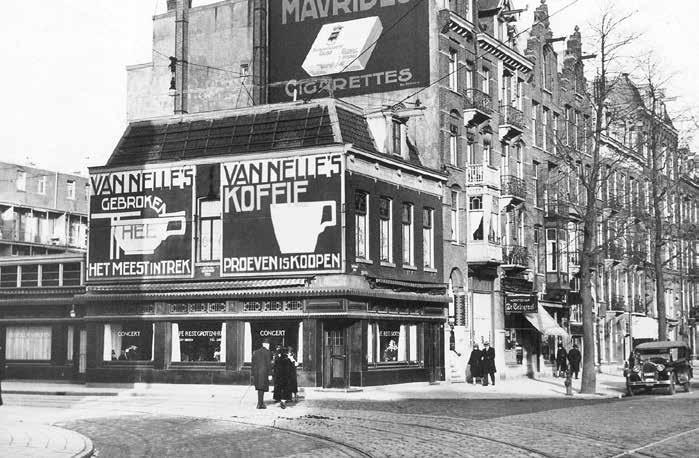
Netherlands were cancelled due to an outbreak of cholera. In a great many cities, the annual funfair was not permitted to go ahead, as the chance of spreading the disease was deemed too great. Amsterdam’s entrepreneurs were not content to leave it at that, and they protested, drawing up a petition in which they noted their main objections: in their view, the measures were in conflict with the law and the result of bad political strategy. Now that they had no turnover, they were threatened with mass bankruptcies. They also believed that the people were suffering, as they needed these kinds of festivals to remain ‘in good humour’. The Amsterdam entrepreneurs’ appeal

also need knowledge from other disciplines, such as economics, psychology and cultural studies, to emerge from the crisis in a balanced fashion. That is all the more important, as we are dealing with a ‘slow-onset disaster’, a silent killer. It also means that after applying the medical miracle, the vaccine, the crisis will not magically be over, as the social consequences will be perceptible for a long time to come.
Without wishing to dismiss any part of the contribution of medical and other specialisms, we argue for better use of historical knowledge in the collective battle against today’s coronavirus crisis. Historians, after all, have deep knowledge of societies and epidemics. The past is effectively an accessible reservoir of knowledge and experience that can be instructive for the future. Of course, every crisis is bound by its culture and its era, but recurring patterns can be discerned, from which we can distil a few valuable insights. We mention four here. Firstly, history shows that epidemic diseases cannot be described from a purely medical perspective, but that they are uniquely social occurrences. The way in which people react to diseases, the political and social interventions, the reporting in the media and the search for moral and social causes for outbreaks are socially, culturally and historically determined. This point is clear from two impressive works offering an overview of the subject: Epidemics. Hate and compassion from the plague of Athens to AIDS (2018) by Samuel Cohn and Epidemics and Society. From the Black Death to the Present by Frank Snowden. Both authors point to the need to place epidemics in a broader social and historical context and not to view them as purely medical problems. New infectious diseases, for example, are systematically coupled with thinking in terms of scapegoats, political unrest and social reform movements. In view of these social dimensions, Richard Horton, editor-in-chief of The Lancet claims that Covid-19 should not be termed a pandemic but a syndemic, emphasising the fact that a pandemic is not exclusively a medical issue, but that it is also embedded in a broader social and ecological context. Secondly, historical research shows that pandemics remarkably often follow the same course. In a 1989 article the historian Charles E. Rosenberg compared the course of an epidemic with a play in four acts. At first just a handful of suspicious cases crop up, but as the disease spreads faster, social unrest grows. Besides going in search of medical and social explanations, people also assign scapegoats who are presumed to have causes the crisis. The unrest then culminates in a crisis, which is also political in character. Invariably riots and protests break out, as forms of social discontent or inequality come to the surface. A known example is the cholera riots in Hamburg in 1892. Residents of deprived areas were furious because the city authorities had neglected to better organise the city water supply. Thirdly, an epidemic is extinguished gradually. In Rosenberg’s words, ‘Epidemics ordinarily end with a whimper, not a bang.’ He is referring to the famous poem The Hollow Men (1925) by T.S. Eliot. With his verses, the American-British poet expressed the collective emotions of futility and depression with which many soldiers and civilians struggled after World War I. To sum it up: an epidemic might end from a medical perspective, but the psychological and social disruption leaves deeper marks. Interestingly the Dutch Association of Mayors recently drew up a letter commenting on the question of how mayors can take the lead in dealing with bereavement in this extraordinary time. The Association points out the great importance of collective mourning – particularly now that many people have had to say goodbye to their nearest and dearest differently from normal. For that very reason, it is important throughout the crisis – and that is the third insight – to pay attention to the issue of a sense of purpose and mental resilience. The past reveals countless rituals to give meaning and coping mechanisms, which are also relevant for dealing with the current crisis. We single out one of them here, namely the cultural forms of resilience. Historical research shows that cultural media (stories, songs, sermons, processions, pictures and charity concerts) had many functions. They not only offered an outlet for emotions such as fear and uncertainty but also provided

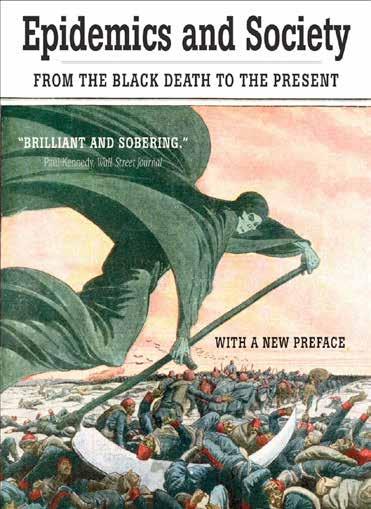
comfort and meaning because they connected people. In particular, the disaster song genre fulfilled this role: singing and mourning together offered comfort and hope. Authors and artists also encouraged a sense of community: they aimed to increase solidarity among citizens by heightening empathy with victims and organising acts of charity. They focused on the question of how the community could come through it as a whole. During the various cholera epidemics (and other catastrophes) an impressive number of citizens’ actions took place, targeting general recovery. The local newspapers also encouraged people to help one another. A wide variety of actions was organised. For instance, in 1849 a race in the seaside town of Zandvoort raised 300 guilders for those in need there. During a charity concert in Rotterdam, 250 people performed to help the community. It is precisely from this that we can draw an important lesson for the current crisis: culture is indispensable for increasing psychological and social resilience. Stories, poems, music, theatre and other art forms offer a medium in which people can escape, reflect and mobilise. For that very reason it is also important in times of crisis to continue to invest in culture in the broadest sense of the word. A fourth and final historical insight is that humanity will always have to deal with new infectious diseases, that risks can never be 100% offset and that we will have to learn to live with the idea that every human being is mortal. Governments currently like to talk about exitstrategies, as if there were a clear, straight line out of the crisis. They make use of ‘dashboards’ showing at what ‘R number’ or reproduction number cinemas and theatres can reopen. Such infographics seem to appeal to our modern urge for control, but more importantly, they suggest that interventions are determined purely by biomedical data. This mechanism is also expressed in the ‘toolbox’ on which Dutch politicians greedily draw to bring the virus under control. It must first be dealt a blow with a hammer, after which society must learn to dance with it. The ministers derive this imagery from the engineer and publicist Tomas Pueyo, who published the very influential article ‘The Hammer and the Dance’ in March 2020. In it he introduces a series of ‘basic dance steps’ which governments should follow to navigate the crisis as efficiently as possible. Among those dance steps he counts matters such as social distancing, contact tracing, hygiene education and banning large events. Pueyo presents a technocratic, top-down approach in which interventions are purely biomedical in character. If we can learn something from the past, then it is that such a top-down, biomedical approach does not sufficiently do justice to the complexity of the current crisis. It would be far better to speak of adaptive strategies. Of course the vaccine will help us, but in order to find the right exit strategy it is also essential that we pay attention to social, economic, psychological and
cultural dimensions of societies. We therefore argue for the development of an alternative choreography, in which social and cultural coping mechanisms also play a role. History can function as a toolbox in that process.


Tanzania’s new leader acknowledged the pandemic and promised more civil rights.
With five words we should ensure they — “Let us have follow the rules,” she a stance” — said. Tanzania’s new president in a Those who suffered speech appeared to welcome a under Magufuli’s new era in which the country’s crackdowns on free government acknowledges the speech and opposition pandemic and in which civil politics say Hassan’s rights might be broadened, words won’t mean fueling both hope and much unless backed up skepticism that she will roll by actions. back some of her predecessor’s “We need quick policies. action, especially Samia Suluhu Hassan took when it comes to over last month when John the pandemic,” said Magufuli died of complications James Mbatia, the from heart disease. He was an chairman of NCCRardent pandemic denialist, and Mageuzi, one of many of his critics allege that Tanzania’s opposition he, like thousands in Tanzania, parties. “The three died of the virus even though most important people the government has released in government were no data on its spread since last present at the speech April. this morning, and no Health officials outside of one had a mask on. Tanzania have warned that I still think they are high percentages of recent not serious about this cases among Tanzanian President Samia Suluhu Hassan: Takes a new approach pandemic.” travelers indicate the That kind of symbolic country has been experiencing an uncontrolled outbreak, indication of intent would go a long way, he said. It was only including of the most mutated of all new variants found one of numerous indicators in Hassan’s speech that gave by researchers. The country has not implemented any critics pause. On the issue of media freedoms, for instance, containment measures. Hassan’s caveat that media must “follow the rules” caused Expectations are high for Hassan, who was formerly the some to doubt whether free speech was really in the offing. vice president, to reverse course on Magufuli’s health Those rules are highly restrictive, said Muthoki Mumo, policies, which included the rejection of vaccines and led to a sub-Saharan Africa representative at the Committee to threats of Tanzania’s being isolated from the international Protect Journalists. If media houses can reopen but not report community. Opposition supporters and rights activists also on issues of their choosing, the move would be hollow, she hope Hassan will try to rebuild Tanzania’s democratic said — especially when there are still journalists in jail and underpinnings, which they say Magufuli nearly obliterated others who have been missing for years, including Azory during his five years in power. Magufuli had shut down Gwanda, who reported on a string of police-related killings. newspapers and websites, created financial barriers to “There is a big problem in what she said because the laws starting new publications, and jailed journalists and of the land, many of them are deeply problematic for the dissidents. media,” she said. “When questions such as what happened In Tuesday’s speech, Hassan gave one indication that to Azory Gwanda are still hanging in the air, there is still a she aimed to open up some freedoms by calling for a question mark.” reinstatement of the licenses of media houses that had been Within Hassan and Magufuli’s CCM, or Revolutionary banned. Party, some were more effusive in their welcoming of the “We should not ban the media by force. Reopen them, and change of tone. The CCM has been in power for decades and

Magufuli, critics alleged, had created a more sycophantic kind of politics, in which dissent from within his party was unheard of. In death, as in life, Tanzania’s Magufuli polarized his country There were exceptions. Hamisi Kigwangalla is an outspoken CCM member of parliament and used his status as a physician to underpin his pleas for greater transparency and action against the coronavirus under Magufuli. On Tuesday, after Hassan’s speech, he said he felt vindicated by her words. “I find the statement by her excellency very much pleasing and forward looking,” he said. “In the first place, we need to change our direction from withholding information and now starting to issue statistics and conduct research on so many facets of the pandemic here in Tanzania and move in the direction of vaccination.” But Hassan did not provide any such details in her speech; she announced plans to create an expert coronavirus task force to advise her government on the pandemic. Two of Magufuli’s fiercest critics, the journalist and activist Maria Sarungi Tsehai, and the opposition leader Tundu Lissu, said they would consider Hassan an extension of Magufuli’s rule until she proves otherwise. “What we really need is systemic change,” said Sarungi, whose Kwanza TV station was shut down twice under Magufuli. “Presidential decrees became laws of the land. As long as that stays the case, we’ll be at the mercy of whoever is in charge.” Deeper democratic reform, which includes the writing of a new constitution, is part of what Lissu is waiting to see before he returns to Tanzania permanently. He went into self-exile in Belgium after a bruising presidential campaign against Magufuli last year in which he was repeatedly arrested. In 2017, during a previous campaign, he was shot multiple times in what he says was a politically motivated
assassination attempt. “Now that she is the president, she must tell us, she must tell the world who was behind these assassination attempts against myself, who was behind the killings of villagers, of fisherfolks, of peasants and pastoralists around our national parks, who was behind the abduction and disappearance of political opponents and media critics,” he said. “If she does that, I will feel very comfortable and return home.” Bearak reported from New York.

Death how can you be so cruel to take Catherine Barinua from us.
Your death occurred on my birthday, 9th April 2021, few months short of your 42nd birthday on 6th July. Spoke with you in February, assured me that you were doing well not knowing that was our departing chat. You had dreams, big dreams for your children, now you will not physically witness their success in life. You laboured for them but you didn’t stay to eat the fruit of your labour. You left families and friends in shock and just wondering why now? Well to God be the glory for the quality time we spent together at Miss Blossom Beauty Pageant. At Global Alliance doing business. Your smile never depart you. Rest on Catherine, no one can harm you again. You find your rest. R.I.P

In Empty Amsterdam, Reconsidering Tourism after pandemic
Before Covid-19, the city was packed with visitors. Now efforts to rein in the expected post-pandemic crowds are ramping up, but not without controversy. When international travel came to a halt last year, Amsterdam like cities everywhere was drained of tourists almost overnight. The effect, according to Sonia Philipse, the owner of the restaurant Lavinia Good Food, was both surreal and serene: Without the crowds, her city was quieter and more beautiful than she had ever seen it. “At this point we’re missing our tourists again,” Ms. Philipse said recently. “But I think there was a moment of really big joy in getting our city back.” It’s a tension that Amsterdam has been trying to navigate for years: how to embrace its status as a vibrant, international hub without making the city unliveable for its residents — and without letting go of its famous, free-spirited roots. Now, with visitor numbers still low, Amsterdam’s leaders are trying to introduce important new restrictions on short-term vacation rentals, sex tourism and cannabis sales to visitors; all in an effort to ensure that old problems stemming from tourism don’t reappear when visitors return. The measures make Amsterdam one of Europe’s frontrunners in taking a hands-on approach to managing tourism. But even as many locals may be enjoying the current quiet in Amsterdam, many also disagree with some of the city’s tactics. The complaints from Amsterdam residents started to crop up in 2013, when tourism had fully bounced back from a downturn following the financial crisis of 2008. Locals said that tourists were being loud and disruptive in the city center; disrespecting prostitutes; occupying short-term vacation rentals that drove up housing prices; and taking over some of the city’s most beautiful, historic areas. Visitor numbers grew steadily every year from then onward — 2020 excepted — and the pressure of all of those tourists continued to escalate. In 2019, a record-breaking 21.7 million people visited Amsterdam, a city with a population of about 870,000. “You see this tipping point where the visitor economy causes more harm for the locals than it adds value, and then you’re in an unhealthy situation,” said Geerte Udo, the director of Amsterdam&Partners, a nonprofit, government-supported organization that manages tourism in the city. “We need to change everything we have on offer in the city center if we want to bring the balance back to living, working and recreating,” she said. Before the pandemic, city leaders had already put in place
a number of measures to try to mitigate the problems stemming from tourism, including a ban on guided tours of the Red Light District; a ban on new hotels in the city center; an increase in the tourist tax; and a ban on new shops that cater to tourists. As early as 2014, Amsterdam stopped promoting itself as a destination in new markets overseas. Instead, the city’s marketing organization worked to guide and manage all of the visitors who showed up in the city. But even with those measures in place, tourism continued to grow, and the rising numbers attracted attention. By 2019, news articles decrying surging tourist numbers mentioned Amsterdam, alongside Venice and Barcelona, as a prime example of over tourism in Europe. Since the pandemic hit, Amsterdam’s leaders led by the mayor, Femke Halsema have continued the push to regulate tourism, with a strong focus on the Red Light District, an ancient part of Amsterdam’s city center and a huge magnet for tourists. On a typical Saturday night before
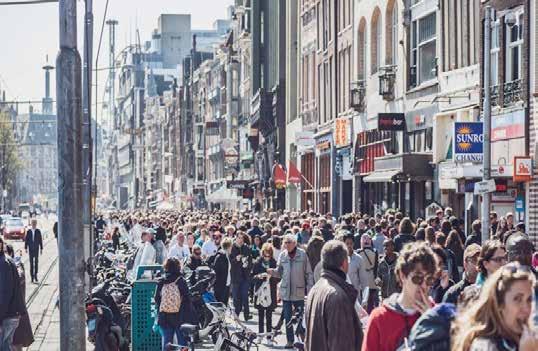
the pandemic, the district, known as De Wallen, would have been heaving with young men going from bar to bar perhaps stepping into sex shops or coffee shops or eyeing scantily clad prostitutes posing in their windows. Several Amsterdammers interviewed for this story said that they would never consider visiting the neighborhood at such a time because of the rowdy, crowded scene. “The public space is dominated by facilities that are almost all redolent of sex, drugs and drink,” Ms. Halsema wrote of the historic city center in an official letter to the city council in July 2019. “Constantly increasing numbers of visitors, misconduct, a shrinking retail mix, rising property prices, commercialization of public space and criminal subversion all call for measures to be taken.” n the same letter, Ms. Halsema proposed four scenarios for the future of sex work in the Red Light District. (Prostitution is legal and regulated in the Netherlands.) One of those scenarios - the relocation of sex workers to a “prostitution hotel” elsewhere in the city has recently attracted the support of a majority of city council members. The proposal has not been fully approved, however; further discussions are scheduled this summer, a spokeswoman for the city of Amsterdam said. Another headline-grabbing proposal from the mayor’s
office would make it illegal for visitors to buy cannabis in Amsterdam’s coffee shops, which are concentrated in the Red Light District and which have long been popular with tourists. The potential effects of such a move are currently being studied, the spokeswoman said. And last summer, in response to complaints about the rise in home sharing, the city imposed a complete ban on all short-term vacation rentals in three neighborhoods in the city center, including the Red Light District. The ban was overturned in court earlier this month, but city officials are now working to find a way to reimpose the measure legally, the spokeswoman said. Amsterdam has also joined more than 20 other European cities to advocate stricter rules on vacationrental platforms at the European Commission and in the European Parliament. The measures are in line with the Dutch hands-on approach to tackling problems, the city’s deputy mayor, Victor Everhardt, said, adding that, while the pandemic had not shifted the city’s course of action, it may have accelerated its pace. Amsterdam residents have high expectations for city life, and politicians aren’t afraid to push through new measures, Mr. Everhardt explained — even if some of those measures may end up being challenged in court. “We’re just moving ahead and dealing with the problem,” he said, adding: “There is no silver bullet.” But some of the proposed measures have proved controversial. The idea of relocating sex workers, for instance, is widely opposed by those who work in prostitution, said Irina, a spokeswoman for PROUD, a union of about 300 prostitutes across the Netherlands. “The problem is not with the prostitutes. We’ve been in the same area for centuries,” said Irina, who declined to share her last name, citing privacy concerns. “The issue is the exploding number of tourists coming to Amsterdam, and they’re coming for a whole bunch of reasons.” Irina noted that the government’s Project 1012; an initiative that closed more than 100 sex-worker windows in the Red Light District over the past decade had done nothing to ease the neighborhood’s overcrowding or reduce disruptive behavior. Instead of focusing on prostitutes, she added, the government should put more police officers on the streets and ramp up the enforcement of existing rules against public urination, public drunkenness and disturbing the peace.
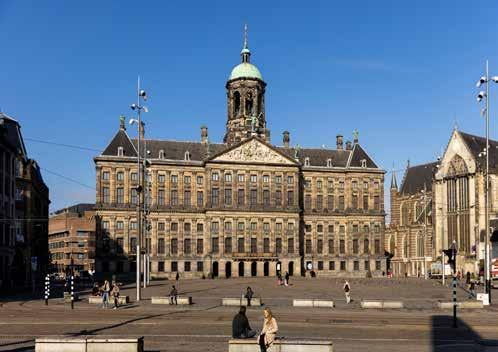
Sex workers “are being scapegoated, together with the coffee shops, for causing the problems which we are not,” Irina said. The mayor’s recent proposal to forbid Amsterdam’s coffee shops from selling cannabis to non-Dutch residents has similarly attracted opposition. Tourists and locals who frequent the city’s 167 licensed coffee shops come to relax, socialize, maybe play a board game and smoke cannabis, which is decriminalized for personal use in the Netherlands. Alcoholic drinks and hard drugs are not allowed. Joachim Helms, a coffee shop owner and spokesman for the
cream parlors and “Nutella shops,” which serve takeaway waffles and other treats smeared in the hazelnut spread, mainly to tourists. Meanwhile, rising housing prices due, in part, to the rise of Airbnb and other vacation rental platforms have made the city center unaffordable for many locals. This monoculture has been thrown into the spotlight over the past year, Ms. Udo said, adding that she had been struck by how deserted the city center has felt during the pandemic, especially compared to other parts of Amsterdam. “That was a real eye-opener,” she said. “There are not enough people living there and working there to get this liveliness back in the neighborhood when the visitors are gone.” Alongside the restrictions proposed by the mayor’s office, city officials and some residents have also tried softer approaches to tackling the problems associated with tourism, some of which were rolled out with success before the pandemic. One critical strategy has been to try to reach visitors before they even arrive. Amsterdam’s Enjoy and Respect campaign, which launched in 2018, targeted the primary source of the behavior problems. Dutch and British men between the ages of 18 and 34 with messages about the fines they could incur by urinating in the street, littering or getting drunk in public areas. A subsequent survey showed that the messages had reached at least part of that audience, but measuring the campaign’s effectiveness has Mayor of Amsterdam, Femek Halsema wants life back in Amsterdam proved to be a challenge. To ease overcrowding in the center, Amsterdam&Partners has been encouraging visitors Dutch Cannabis Retailers Association, said that the proposed to explore other parts of the city, such as Amsterdam Noord, ban would force visitors to buy their cannabis on the street, where a former industrial shipyard hosts flea markets, music where they are more likely to be taken advantage of; it would festivals and outdoor movie screenings in the summer. In also damage Amsterdam’s reputation as an international city, Nieuw-West, visitors can sample local nightlife or stroll he said. around Sloterplas Lake. But even if such areas are successful “If people have experienced a lot of disturbance from tourists in attracting visitors, it can be difficult to get substantial in the city, then of course you have to look at where that numbers of tourists to move away from the most popular disturbance comes from,” he said. “Usually, it’s guys being spots. loud on the street and being drunk and those aren’t typical “People often arrive with a lot less orientation and coffee shop people.” understanding of where they’re visiting than we imagine, and Support for the prostitutes and coffee shop owners was echoed hence they end up in the same city-center neighborhoods,” in several interviews with Amsterdam residents, including said Peter Jordan, head of insights at Toposophy, an agency Roy Van Kempen, a 31-year-old marketing manager who has that has advised Amsterdam&Partners. “That happens in lived in Amsterdam since 2008. cities everywhere and it happens in Amsterdam.” “Paris has the Eiffel Tower, and we have the Red Light District The Red Light District and other neighborhoods between and this idea that everything is possible in Amsterdam. And I the city’s Central Station and Dam Square tend to attract would like to keep it like this, actually,” he said. the biggest crowds, Mr. Jordan said, as well as the areas But Irina, Mr. Helms, Mr. Van Kempen and half a dozen other immediately around major attractions like the Rijksmuseum Amsterdammers interviewed agreed that the city center has and the Anne Frank House. Of these, he added, the Red Light a major problem: A tourism “monoculture” has taken root, District faces the biggest challenges. and residents are being pushed out. Businesses and services Elena Simons, one of the leaders of Amsterdam’s Reinvent that used to cater to locals — high-quality bakeries, butcher Tourism movement, is working to find new and constructive shops, and the like have been replaced by trinket shops, ice- ways to engage the city’s tourists. Ms. Simons is also one of

the authors of “The Untourist Guide to Amsterdam” and the co-creator of a project that allows tourists to “marry an Amsterdammer for a day.” This alternative tour, which launched in 2019, is a four-hour experience that starts
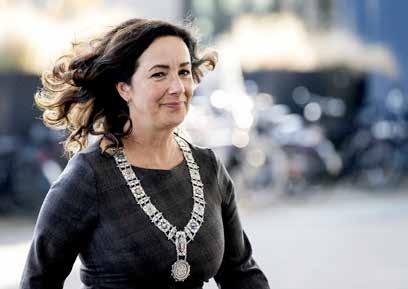
with a fake wedding (rings, gown and flowers included) and includes a personalized jaunt around a lesser-known part of the city. The point of such efforts, Ms. Simons said, is to find ways for tourists to make meaningful connections with Amsterdam residents, and even to have a positive impact on the city — whether by weeding at an urban farm or joining a weekly litter cleanup. The organization’s work was cut short by the pandemic, Ms. Simons said, but she is optimistic that interest will pick up quickly when visitors return. However, with Covid cases on the rise again in the Netherlands and many other European countries, it may still be some time before travelers from outside the Continent are able to visit. Mr. Jordan, the tourism analyst, said that other European tourist destinations that are dealing with similar challenges could learn a lot by studying Amsterdam’s experiences. “Something that I admire about Amsterdam is that they’ve been prepared to be honest and show that they recognize what the issues are and very visibly take steps to deal with it,” Mr. Jordan said, “because other cities haven’t necessarily got that far.”


US lifts Trump administration’s sanctions on top ICC prosecutor
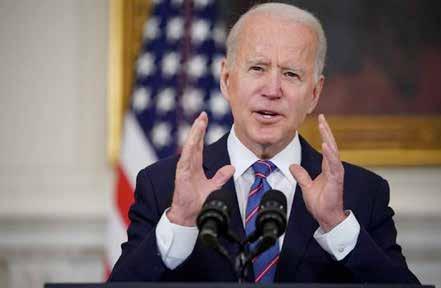
Former United States Secretary of State, Mike Pompeo had imposed sanctions after Fatou Bensouda launched investigation into alleged war crimes by US military in Afghanistan. However, the new administration of President Biden has lifted sanctions and a travel ban imposed by Donald Trump’s administration on the top prosecutor of the International Criminal Court, calling for a more cooperative relationship. The former secretary of state Mike Pompeo last year imposed sanctions and refused visas for the outgoing prosecutor, Fatou Bensouda, after she launched an investigation into alleged war crimes by US military personnel in Afghanistan. The court in The Hague further irritated the US by opening an investigation into alleged war crimes in the Palestinian territories by Israel, a US ally which rejects the authority of the court. Pompeo’s successor, Antony Blinken, said the United States continued to “disagree strongly” with the moves. “We believe, however, that our concerns about these cases would be better addressed through engagement with all stakeholders in the ICC process rather than through the imposition of sanctions,” Blinken said in a statement. He said that both the sanctions and visa bans against Bensouda
and her staff were being lifted. “I trust this decision signals the start of a new phase of our common undertaking to fight against impunity” for war crimes, said Silvia Fernandez de Gurmendi, the head of the Association of States Parties to the ICC, in a statement. The Gambian-born prosecutor is leaving her job in June and will be replaced by British human rights lawyer Karim Khan, who now can open his work without the burden of looming
sanctions. The US has not joined the ICC, which began operations in 2002 after enough countries ratified the treaty that created it, claiming that the court might be used for politically motivated prosecutions of American troops and officials. But the removal of the sanctions was the latest signal that the Biden administration is intent on returning to the multilateral fold. The Trump administration had unapologetically removed the US from numerous international institutions and agreements and harshly criticized others, including the ICC, deeming them flawed and working against American interests. Since Biden took office, his administration has rejoined the World Health Organization, re-engaged with the UN Human Rights Council, returned to the Paris climate accord and started talks aimed at returning to the Iran nuclear deal. Trump had pulled out of all five. Human Rights groups applauded Biden for throwing out Trump’s sanctions but called for Biden to go further, by supporting the court’s work and making the US a member country. Two sets of sanctions were imposed on Bensouda and the court’s head of jurisdiction, Phakiso Mochochoko, the first being a travel ban on Bensouda in March 2019, and then 18 months later a freeze on any assets she and Mochochoko may have in the US or US jurisdictions. The second round also made giving the pair “material support” a potentially sanctionable offense.

Central Bank of Kenya (CBK) is looking at developing a framework that will offer special incentives to Kenyans abroad who set up businesses back at a home. Governor Patrick Njoroge says the findings of a survey the bank ran on Kenyan diaspora and recipients locally will inform the development of a facilitative policy that encourages increased targeted direct investment flows by citizens living and working abroad. CBK partnered with the Foreign Affairs ministry and Kenya National Bureau of Statistics in conducting a poll on the diaspora between January and March 2021. “There are all sorts of ways that the Kenyans out there could be supportive (to economic development), not just making investments in government securities and other assets like equities,” Dr Njoroge said. “They can set up shops here; they can have direct investments … as has happened in other countries like India, not just portfolio investments.” Kenya Diaspora Alliance (KDA) says about three-quarters of remittances, however, go into family support such as school fees and medical bills. Shem Ochuodho, the KDA global chair, insists this could be reversed in favour of direct investments if the citizens abroad were offered incentives such as tax rebates.

Egypt, Ethiopia, Sudan talks fail to break Nile Dam deadlock
The long-running dispute over Ethiopia’s mega-dam is still going nowhere. But Sudan’s Prime Minister has invited his Egyptian and Ethiopian counterparts for a closed meeting discussion which we gathered offers a glimpse of hope. It comes after talks hosted by the African Union between Cairo and Adis Ababa failed to reach a binding agreement over the Grand Ethiopian Renaissance Dam (GERD) and the filling of its vast reservoir. Ever since construction began in 2011, Egypt has regarded the dam as an existential threat to its water supplies, while Sudan fears its own dams would be harmed if Ethiopia fills the reservoir without a deal. “The case of the water issue cannot be solved through this. It will not be solved through war. At war, you don’t know the setting and the final destination. It is harmful,” said Ethiopian foreign ministry spokesman Dina Mufti. “We have to solve this in a modern way, through discussion, and a diplomatic manner, and this is a very thoughtful and useful way of thinking.” The statement said the planned summit will be held by videoconference. “Prime Minister Abdalla Hamdok invited his Egyptian counterpart Mostafa Madbouli and Ethiopian counterpart Abiy Ahmed to a summit within two weeks to evaluate the negotiations regarding GERD,” the premier’s office said in a statement.
It said Hamdok expressed concern the dam’s construction had reached an advanced stage, making “reaching a deal before the start of operation an urgent and pressing matter”. Last month, Ethiopia offered to share data with Egypt and Sudan, but the proposal was rejected by Khartoum and Cairo which complained of “fallacies” in the figures and an “unacceptable tendency” by Addis Ababa to take unilateral steps.












